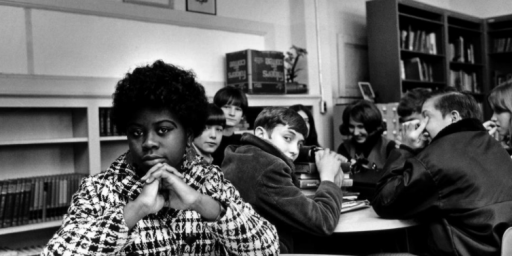How Far Have We Really Come?
Washington Post Magazine has a series of stories this week commemorating the 50th anniversary of the landmark Brown v. Board of Education. The pieces all center around the urban schools in the DC metro area, especially the District and Maryland.
The lead-in story (in the paper edition, it’s not arranged that way on the web) “Fear of Failing” is rather odd, in that it takes an anecdote from twenty years ago about teachers thinking poor, minority kids shouldn’t be challenged, cites a largely unrelated statistic from today, and concludes that we’re still doing the same thing. Indeed, my guess is we still are, but I’d prefer at least a more recent anecdote! Regardless, it’s difficult to argue with this sentiment:
In many cases, this attitude springs from humane instincts. No one wants to hurt a child, and that is particularly true of teachers, who commit themselves to very long hours with barely adequate pay out of eagerness to help young people. To argue, as many educators I admire do, that the overdose of kindness given to low-income children is often a form of racism and classism, corroding students’ future choices, is to risk being called an interfering elitist. What is wrong, I have heard well-meaning teachers ask, with the honest menial labor that many of these academically challenged students will do for a living? Not everybody has to go to college, they say. Which of course is right, but very premature. Deciding children’s futures before they graduated from high school was one of the outrages that led to Brown.
“Beyond Black and White” takes a look at Montgomery Blair High School in Maryland, where “every student is a minority.” The main thing I learned from the piece is that students are still listening to Michael Jackson and break dancing–indeed, I thought it was a retrospective piece until I realized they didn’t have Diskman’s back “in the day.” Not surprisingly, racial adherence still exists:
Some of the old divisions still exist. Blair’s two most touted academic tracks — the science, mathematics and computer science magnet program, and the communication arts program — are overwhelmingly white and Asian. Regular classes, meanwhile, are filled mainly with black and Hispanic students. In remedial classes for kids struggling to read on an elementary school level, there often are no white kids at all.
The academic achievement gap is accompanied by another gap that is not as easily defined. Many of Blair’s cliques break down along racial lines, and so do many of its extracurricular activities. The ultimate Frisbee team, for example, is almost entirely white. The tennis and volleyball teams are mostly Asian. The step team is dominated by African American performers.
There are several other stories, but you get the idea. I suppose the mere fact that we’re still making such a fuss about race in the schools half a century after Brown is a pretty good answer to the cover question on its own.





